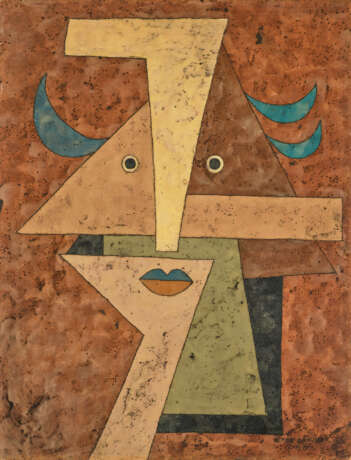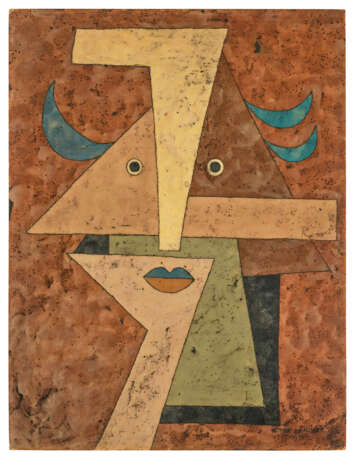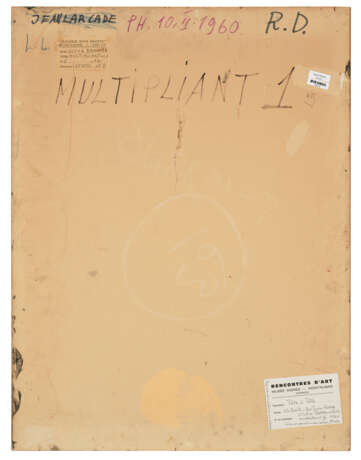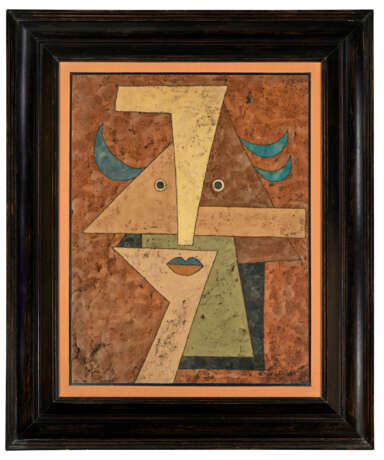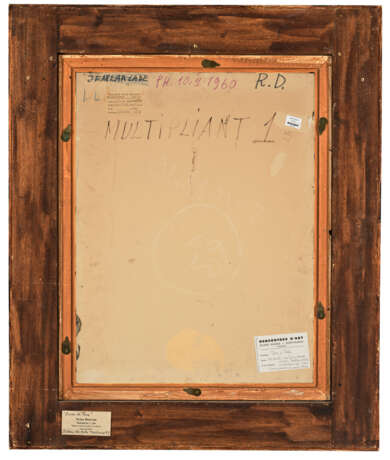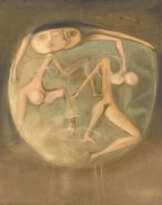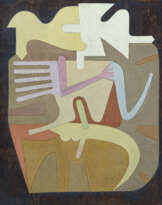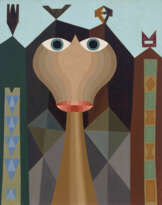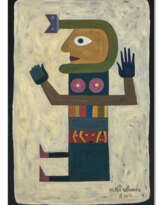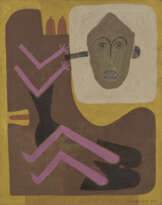ID 1302218
Lot 119 | Victor Brauner (1903-1966)
Estimate value
€ 80 000 – 120 000
Multipliant I
signé et daté 'VICTOR BRAUNER. I. 1960' (en bas à droite)
huile, cire à l’encaustique et plume et encre sur Isorel
65.6 x 50 cm.
Peint en janvier 1960
signed and dated 'VICTOR BRAUNER. I. 1960‘ (lower right)
oil, encaustic wax and pen and ink on Masonite
25 7/8 x 19 ¾ in.
Painted in January 1960
Provenance
Galerie Rive Droite (Jean Larcade), Paris (acquis auprès de l’artiste en mai 1960).
Collection particulière (en 1987).
Galerie Melki, Paris (en 1990).
Acquis auprès de celle-ci (avant 1993).
Literature
Y. Kobry, 'Brauner, L'éloge des chimères', in Beaux-Arts, septembre 1987, No. 49, p. 54 (illustré en couleurs, p. 55).
D. Semin, Victor Brauner, Paris, 1990, p. 314 (illustré en couleurs, p. 268; titré 'Sans titre').
Exhibited
Paris, Galerie Rive Droite, Victor Brauner, Espaces hypnotiques, février-mars 1961, no. 10.
Tanlay, Centre d'Art Contemporain, Château de Tanlay, Victor Brauner, Arts Primitifs, juin-septembre 1987, p. 46, no. 39 (illustré en couleurs, p. 27).
Montauban, Musée Ingres, L'artiste regardé, Un point, deux vues, mai-juin 1993, no. 3 (illustré en couleurs; titré 'Multipliant II').
Toulouse, Espace d'Art moderne et contemporain, Prises de Terre, Potlatch pour Noël Arnaud, novembre-décembre 1997, p. 35 (illustré en couleurs, p. 29).
Saint-Cirq-Lapopie, Château de Saint-Cirq-Lapopie, Victor Brauner, été 2001, no. 2.
Montauban, Musée Ingres, Tête à tête, avril-juin 2004, p. 27 (illustré en couleurs; titré 'Multipliant II'; daté '1961').
Further Details
"'Multipliants' : Formes et matières organisées en figures humaines. Rêveries sur les matières qui s'immatérialisent dans leur unification anthropomorphique."
Victor Brauner, in Victor Brauner, Espaces hypnotiques, cat. exp., Galerie Rive Droite, Paris, 1961.
"'Multipliants': Forms and materials organised into human figures. Musings on materials that become immaterialized in their anthropomorphic unification."
Victor Brauner, in Victor Brauner, Espaces hypnotiques, cat. exp., Galerie Rive Droite, Paris, 1961.
Représenté frontalement, par le biais d’une superposition de formes géométriques, dans des nuances de beiges, de marrons et de verts, Multipliant I semble faire écho aux cailloux et pierres de la vallée de Théus, le long de la Durance, lieu ayant inspiré le dessin à la bougie à Brauner dès 1942. Le présent visage, au regard fixe, prend vie par la réunion de plusieurs formes imbriquées les unes aux autres ; c’est d’ailleurs cette démultiplication des formes qui donne son nom au personnage ici dépeint par l’artiste. Cette figure est représentée sans aucune profondeur, une habitude stylistique adoptée par Brauner depuis la perte de son œil gauche dans un accident tragique en 1938 qui lui fait perdre toute notion de troisième dimension, et de manière minimaliste en seulement quelques nettes incisions dans la couche de cire supérieure. La texture de la cire qui couvre l’œuvre vient contrebalancer l’image plane du visage et apporter de la douceur à cette composition géométrique rigoureuse.
Brauner réintègre officiellement le groupe de Breton en 1959 et participe la même année à l’Exposition inteRnatiOnale du Surréalisme (EROS) à Paris. Cette période, celle du début des années 1960, correspond à une simplification des formes, une économie de couleurs et une purification de la technique. C’est une sorte de retour aux principes fondamentaux acquis par Brauner après de longues années d’expérimentations au sein du Dadaïsme, du Surréalisme et de l’Avant-Garde. Peint en janvier 1960, Multipliant I démontre que l’artiste ne se départ plus des formules plastiques qu’il a élaborées pendant la guerre ; même une fois retrouvée la relative facilité d’approvisionnement en matière de peinture.
Represented frontally, through a superimposition of geometric shapes and in shades of beige, brown, and green, Multipliant I seems to echo the stones and rocks of the Théus valley along the Durance, which inspired Brauner’s candle drawing in 1942. The present face, with a fixed gaze, comes to life through the assembly of several interlocking shapes; it is indeed this multiplication of forms that gives the character depicted here its name. This figure is portrayed without depth, a stylistic habit Brauner adopted after losing his left eye in a tragic accident in 1938, which deprived him of the perception of the third dimension. It is depicted in a minimalist manner with only a few clear incisions in the top layer of wax. The texture of the wax covering the work counterbalances the flat image of the face and brings softness to this rigorously geometric composition.
Brauner officially rejoined Breton's group in 1959 and participated in the International Exhibition of Surrealism (EROS) in Paris the same year. This period, the early 1960s, marked a simplification of forms, an economy of colors, and a purification of technique. It is a sort of return to the fundamental principles acquired by Brauner after many years of experimentation within Dadaism, Surrealism, and the Avant-Garde. Painted in January 1960, Multipliant I shows that the artist no longer abandons the plastic formulas he developed during the war, even once the relative ease of obtaining painting materials was restored.
| Artist: | Victor Brauner (1903 - 1966) |
|---|---|
| Applied technique: | Oil on canvas |
| Auction house category: | Paintings, Watercolors, Drawings, Paintings |
| Artist: | Victor Brauner (1903 - 1966) |
|---|---|
| Applied technique: | Oil on canvas |
| Auction house category: | Paintings, Watercolors, Drawings, Paintings |
| Address of auction |
CHRISTIE'S 8 King Street, St. James's SW1Y 6QT London United Kingdom | |
|---|---|---|
| Preview |
| |
| Phone | +44 (0)20 7839 9060 | |
| Buyer Premium | see on Website | |
| Conditions of purchase | Conditions of purchase |
